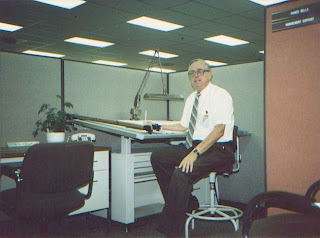We helped usher in the “jet age”
by Jim A.
I am 93 years old, and my wife is 88.
We met at Lockheed’s Burbank Factory B-1. We were high school grads, working to
help build the old Hudson Bombers. I had hired into Lockheed in 1940, and my
wife (Phyllis) was hired in 1942. I retired from Lockheed Skunk Works
in 1974, having by then earned my Master of Science. Phyllis worked many years
at Lockheed, off and on, but did not formally retire from the company. She, too,
had earned her master's degree. One more rather interesting fact is years later,
we both ended up going back into the workforce working for the Martin Marietta before
the merger with Lockheed. We finally retired from Martin in 1987.
I wanted to share some lesser-known
facts regarding Skunk Works and the development of the XP-80 (Lulu Belle) jet
fighter plane in 1943. It was the start of Skunk Works.When Kelly Johnson received the
contract for the XP-80 jet fighter, there was no available space to manufacture
a new airplane. Finally, in desperation, it was decided to place the design group in the model shop and to construct a
very heavy tent connecting to the model shop for the fabrication of the aircraft.
This had one advantage, as it was located at the extreme end of the B-1 complex,
thus few people were in this area.
Security was very tight. To enter the
facility, personnel had first to be checked by an Air Force guard, then checked
by a Lockheed guard. During manufacture,
outside parts such as electric motors and cockpit control gauges were delivered to private homes. The name
Lockheed never appeared on purchase orders. I was young, newly married, and my
wife, Phyllis, working in the plant had no idea what I was involved in
after I entered the large tent. We employees kept our mouths shut,
period.
You may have heard how the Skunk Works got
its name, but
I will retell it for those
who may not know. In the 1940s, there was a very popular comic strip by AI Capp
featuring Li’l Abner, his girlfriend and some rough scroungy individuals, living in a cave
called "Skunk Works," where they made whiskey that was named "Joy
Juice."
Well, one of the young Skunk Works design engineers answered the phone during
Kelly Johnson's absence and said, "Skunk
Works, we are all out of Joy Juice," and it cracked up the whole
design group. So every time Kelly was gone and the phone rang it was answered "Skunk Works." Kelly did not like the name Skunk Works at all, but somehow it
stuck, and it became the
name for the secrete development shop.
It is
interesting our small group designed and built Lulu Belle in 143 days (seven days under what Kelly had promised the
Air Force he would deliver the aircraft). Normally it took one to two years to
develop a new model aircraft. Of course, we had complete freedom to proceed without the customer looking over our shoulder; no
detail customer inspection during construction, no company formal change orders,
no formal design reviews, no shop orders, no waiting for approved blueprints
for the shop. The shop built parts and assemblies right from the design Vellum. If the
shop had a problem in fabrication to
the Vellum,
the drawing design
engineer would be called out to the shop and in most
cases, he would mark change corrections on the Vellum, sign his initials on the
Vellum, and that was our change order. The design group and shop worked hand in
glove together.
Another interesting item in the development
of the XP-80, was the collapse of the inside of the air intake ducts and the damage to
the jet engine. At this time period, the United States had no jet engines, and
jet aircraft was unheard of in our country, although Germany and England were
involved in jet aircraft development. The XP-80 was designed around the British
de Havilland H-1-B turbojet engine. When the engine arrived in California, along
with the English jet engineers, they were concerned about the sheet metal
structure on the inside of the air intake ducts that furnished compressed air
to the jet engine. Lockheed engineers felt the ducts were designed and constructed
strong enough to withstand the impelled suction of the compressed air as it
passes on to the engine.
At
California Muroc Restricted Air Base, the aircraft with, the British jet engine
installed,
started
static power run-ups at 10 percent intervals and as 70 percent power was
reached, the inside of the air intake ducts collapsed sending sheet metal
fragments and rivets into the engine impeller. Close inspection of the jet engine impeller
revealed the damage was severe and a new engine would be required. By the time
a new English engine arrived and the intake ducts were redesigned and fabricated, we had lost two
months’ time, and the first flight was the early morning of January 8, 1944, by Chief Test Pilot Milo Burcham.
The
XP-80 is now in the Smithsonian Museum, and I have visited it on two occasions and touched the ailerons and wing
tips, the assemblies I personally made from
flat metal to final installation. The aircraft is like an old friend to me.
 |
| 'Thanks Old Friend! |










